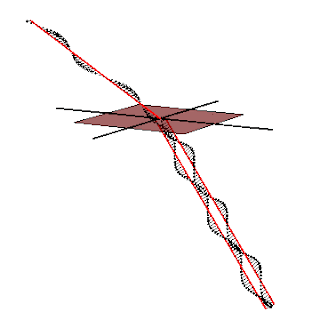Observation of the Spin Hall Effect of Light
 Onur Hosten (left) and Paul Kwiat (right) [Photo credit: L. Brian Stauffer]
Onur Hosten (left) and Paul Kwiat (right) [Photo credit: L. Brian Stauffer]Physicists Onur Hosten and Paul G. Kwiat, at the University of Illinois at Urbana-Champaign showed that light exhibits a Spin Hall effect, analogous to the Spin Hall effect in electronic systems, showing the universality of the effect for particles of different nature. The researchers used a novel technique from quantum weak measurements to enhance the tiny Spin Hall displacements prior to observation.
Whenever the propagation direction of a beam of light changes due to a variation in the refractive index of the medium (in the experiment, refraction at an air-glass interface serves this purpose), the beam center experiences a spin-dependent (or circular polarization-dependent) displacement perpendicular both to the initial propagation direction and the change in the propagation direction, i.e. a lateral shift. Two different spin components (parallel and anti-parallel to the propagation direction) acquire opposite displacements. This is the spin Hall effect as it applies to light. Therefore, when a beam of linearly polarized light (which is an equal combination of spin parallel and anti-parallel to the propagation direction) changes direction, the beam slightly splits into two beams, each containing different spin states.
 Figure 1: Spin Hall effect of Light. (Click on figure to watch it) In the animation, a beam of linearly polarized light incident on an air-glass interface slightly splits into its two spin components -- spin parallel or anti-parallel to the propagation direction (or right and left circular polarizations) -- upon refraction at the interface. [Animation credit: Onur Hosten]
Figure 1: Spin Hall effect of Light. (Click on figure to watch it) In the animation, a beam of linearly polarized light incident on an air-glass interface slightly splits into its two spin components -- spin parallel or anti-parallel to the propagation direction (or right and left circular polarizations) -- upon refraction at the interface. [Animation credit: Onur Hosten]The effect takes place due to conservation of angular momentum (spin plus orbital). Due to the rotational symmetry around the axis perpendicular to the interface (z-axis), the total angular momentum of light around this axis has to be conserved. Assume that, initially the spin angular momentum of light is either parallel or anti-parallel to the propagation direction, and has a certain component along the z-axis. When light refracts at the interface, the spin still remains either parallel or anti-parallel to the new propagation direction. But this time the spin makes a different angle with the z-axis, therefore the spin angular momentum component along the z-axis changes. The spin Hall effect compensates for this change in the angular momentum component, and light acquires an orbital angular momentum by shifting itself laterally from the z-axis.
In the experiment a linearly polarized laser beam was incident on a glass prism at an angle. Upon refraction, the two different spin components acquired opposite displacements out of the plane of incidence. Because the separation between these two beams was only on the order of nanometers, and the beam widths themselves on the order of millimeters, the two beams overlap to a great extent. The researchers measured the separation between the two beams using a novel metrological method (quantum weak measurements in pre- and post-selected systems) to measure the miniscule effect.
Essentially, the spin Hall effect performs a weak measurement of the spin state of the photons. If the measurement were to be strong, the beams corresponding to different spin states would completely separate from each other, and one would be able to tell the spin state by looking at the beam position. But, in the University of Illinois experiment, the spin state measurement was a weak measurement, because the beams were still overlapping to a great extent and one could tell only very little about the spin state by looking at the position of the beam.
When the researchers made a particular pre- and post-selection on the polarization state of the photons before and after the weak measurement (i.e., the spin Hall effect), due to an interference effect between the two beams, there resulted an enhancement of the original displacement by a factor of ten thousand. This pre- and post-selection step experimentally amounts to sending the photons through two calcite polarizers, one before and one after the spin Hall effect, oriented at angles almost perpendicular to each other. Therefore, for instance, an angstrom displacement was enhanced to a micron displacement. Then the enhanced displacement was read by a position-sensitive photodiode (a photodiode split into two halves – the difference signal is proportional to the beam displacement). The researchers were thus able to characterize the Spin Hall effect of light with angstrom resolution.
The measurement technique holds further promise for achieving better resolutions. In particular, the researchers believe that by incorporating standard signal modulation and lock-in detection techniques, a resolution of picometers can be achieved. Moreover, the technique is not limited to position measurements; similar tricks in the appropriate experimental conditions will enhance any kind of signal, e.g., position or momentum of any particle, intensity (e.g. photon number) or amplitude (e.g. electric field) of a field.
The researchers think that it would be interesting to demonstrate the case when the index of refraction varies continuously (as opposed to observing the effect at a discrete air-glass interface), which is the analogous case for the spin Hall effect in semiconductors. The researchers are also theoretically looking for systems where they can separate the spin states into two completely separate beams, and use this for both quantum and classical optical information processing applications.
Reference:
"Observation of the Spin Hall Effect of Light via Weak Measurements"
O. Hosten and P. Kwiat,
Science 319, 787 (2008); published online 10 January 2008 (10.1126/Science.1152697).
Link to Abstract
Link to Full text in the website of Kwiat Quantum Information Group
Labels: Condensed Matter, Laser 1, Quantum, Quantum Computation and Communication

0 Comments:
Post a Comment